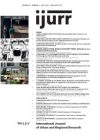‘My dream is that one day this will be cidade,‘ sighed Dona Cristina. Luanda was in the midst of a post-conflict oil-funded construction boom, in which new buildings, roads and infrastructures were rapidly transforming the cityscape, promising opportunities of comfort and care to the general population. A desire to be incorporated into the benefits that the transforming city proffered was not unusual. Dona Cristina lived in Cazenga, a municipality that had been considered part of Luanda since before independence when it was a center of industrial production. Much of the area was made up of self-built homes crisscrossed by dirt roads. In older parts of the area, colonial-era constructions and jagged asphalt throughways pointed to various cycles of colonial and post-colonial state intervention. While her particular neighbourhood was only densely settled in the 1990s, it was now more than twenty years later. The tightly packed concrete-block homes, taxi routes, and administrative divisions all pointed to the area’s material and institutional integration into Luanda, and yet her statement suggests that she did not view the area as cidade – city.
Her statement makes more sense when one realizes that, in Angola, the word cidade means so much more than its literal translation. Often used to refer to the city’s original colonial-era urban core or formally planned areas more generally, it in fact has broader meanings that carry with them notions of race, development, and status, bound up in idealized aesthetic understandings of the urban. These notions have a material life, rooted in an aesthetic defined by historically shifting judgements regarding what it means for spaces and buildings to ‘look’ formal and evoke imaginations of modernity. Juxtaposed to the concept of cidade is what Angolans refer to as musseque or bairro. In the colonial period the word musseque was used to describe areas inhabited by Africans and characterized by the ‘huts’ (Monteiro 1973, Moorman 2008). The word has come to describe a wide variety of settlement types that often seem to have little in common (Development Workshop 2005), only bound by the fact that they fail to meet the aesthetic ideals of what constitutes cidade, whether this be due to their construction materials, lack of infrastructure provision, or informal construction. Dona Cristina’s aspirations did not describe a desire for Cazenga’s recognition as cidade, but rather its material transformation into cidade, which promised to bring the amenities, comforts and status of the formal city into her life.
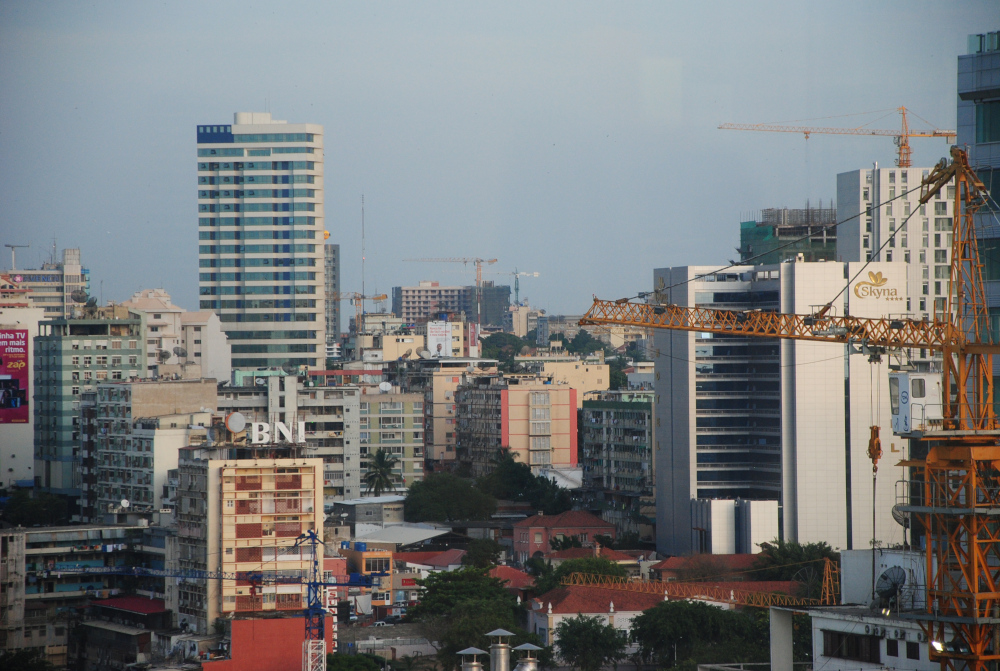
Luanda under construction. Photo: Luis Pedro Fonseca, 2011. Used with permission.
While Dona Cristina’s comment spoke to everyday desires, aesthetic considerations are increasingly creeping into the centre of urban policy and politics. This has become especially evident in the face of two phenomena: the challenges urban administrations face in governing rapidly expanding cities and the growing prominence of master-planning and ‘new city’ building in much of Africa. As Ghertner (2015) has shown in the case of Delhi, aesthetic deliberations became the grounds for managing occupation and spatial usage as city administrators found it increasingly difficult to rely on statistical and other official measures to plan and implement urban governance initiatives. In this sense, aesthetics has come to have a disciplinary power, especially in much of the Global South, where appeals to modernity and the ‘world-class city’ have become the grounds for the capture of urban planning by middle-class and elite desires, often accompanied by the eviction of the poor and the disregard of their contributions to the making of urban space and life. The story, of course, as Dona Cristina’s wish suggests, is more complex than a narrative of a caricatured venal elite standing in opposition to the desires of ‘the people.’ As De Boeck (2011) and Harms (2012) have shown in their respective studies of Kinshasa and Ho Chi Minh City, the kinds of urban modernities promised in the shifting imaginations of cidade are often desired by the general urban population. New city developments proffer possibilities of improved infrastructures and visions of a life made easier by better social services, leisure areas and the seeming presence of a responsive state. Aesthetic promises are seductive, papering over the structural and material violence that their realization implies. However, their embrace by planners also highlights an equally pernicious aspect of aesthetic hegemonies – the ways in which they stunt conceptualizations of past, present and therefore future African urbanisms.
Mournable spaces
My experience of Luanda has always been haunted by a construction that I never actually personally encountered – the Kinaxixe Market. A municipal market designed by one of the most famous architects of Luanda’s ‘Tropical Modernist’ school, Vasco Viera Da Costa, the market was constructed in the early 1950s. The building survived Angola’s civil war (1975-2002), only to be destroyed by the peace. In July 2008 the market was knocked down. In its stead, a multi-million-dollar mixed-use development referred to as ‘Complex Kinaxixi’ was to be erected. The transformation of a public space of imagined cross-class conviviality into a privatized haven of elite consumption represented for many the problems at the heart of Luanda’s post-conflict remaking. What critics described as bland international markers of the ‘world class city’ were replacing historical buildings and sites, disavowing the affective ties that the population had developed to a city that had become a haven during the country’s protracted conflict.
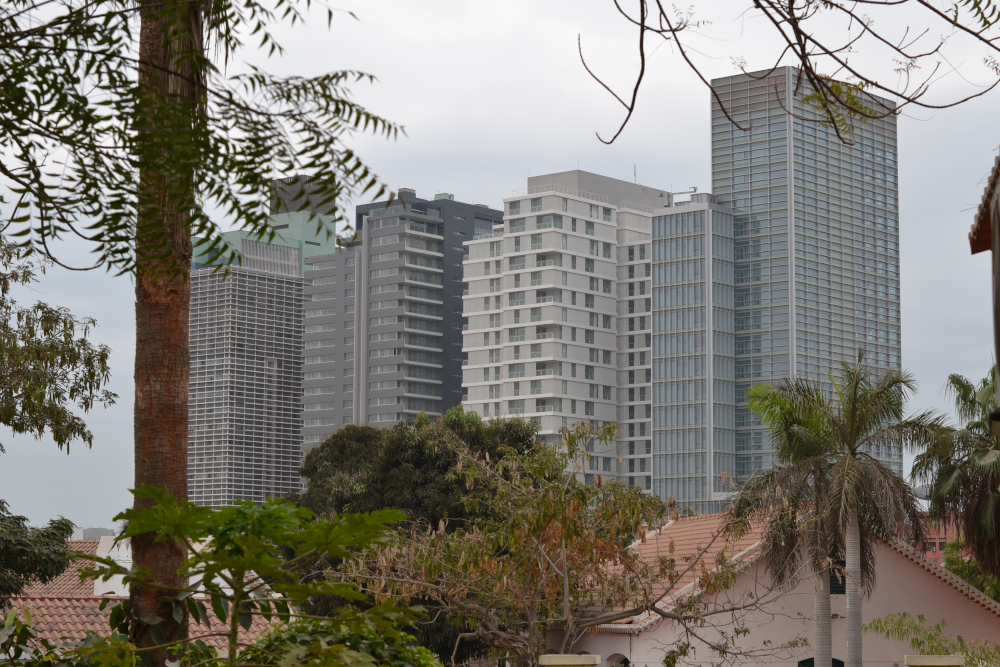
‘World-class’ urbanism. Luanda, 2013. Photo: Luis Pedro Fonseca. Used with permission.
The outrage regarding the destruction of Kinaxixe Market was palpable. The Association of Angolan Architects denounced the demolition, describing the market as: ‘the symbolic body of our independence, of our cry of freedom present in the city and of our contestations with the colonial regime’ (Prado Coelho, 2008: 4). While Kinaxixe’s destruction was, no doubt, evidence of the greed driving Luanda’s oil-boom fuelled redevelopment, it also signified something else – the long-standing prejudices about what and who counted as properly ‘urban’ and thus what kinds of urbanism were mournable. These prejudices were highlighted by Luiz Araujo, one of the founders of a housing rights organization, SOS Habitat. In a letter aimed at the general public he wrote that the destruction of Mercado Kinaxixe and other colonial-era buildings was evidence of a ‘new civil war taking place on Angolan territory,’ in which, ‘the government of José Eduardo dos Santos has destroyed and thrown away the material and cultural wealth of our country. In order to generate wealth for a few individuals, part of the collective memory of Luanda and the entire country has been transformed into historical ruins’ (Araújo 2008). But Araújo, unlike many other people, did not limit his vision of ‘patrimony’ to the historical buildings of the city centre. Instead he used the opportunity to highlight an equally worrying trend that had characterized the post-conflict oil boom: the demolition of musseques and the accompanying forced removal of hundreds of thousands of Luanda’s residents to low-cost housing projects on the urban edge. This process, he argued, repeated colonial segregation patterns with the poor now being forced into what he described as new ‘native quarters’. If musseques are not mournable, this not only means that violence can be enacted against them with impunity but that their contributions to possible futures are overlooked.
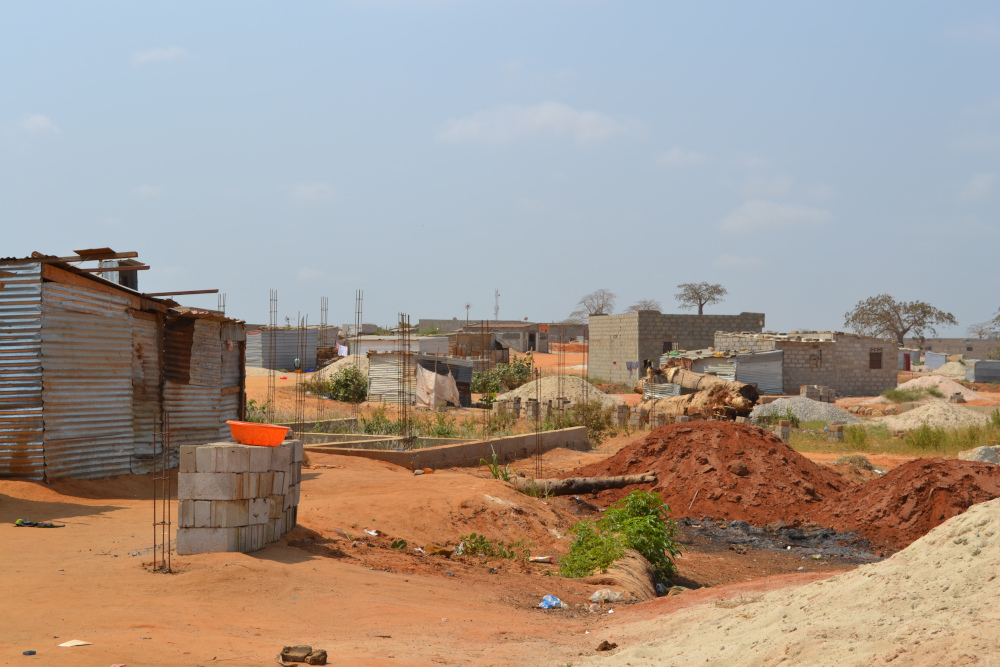
Emerging neighborhood. Luanda, 2012. Photo: Claudia Gastrow.
Araújo’s linking of the destruction of the musseques to the destruction of the historical city centre was unique. While both acts were often reported on, the descriptions thereof were very different. Mercado Kinaxixi, the Palácio de Ana Joaquina, the Cuca Building and other colonial-era buildings within the boundaries of the formal city were mourned as losses to Angola’s collective memory. Despite the fact that the musseques have existed as long as the cidade, their concrete-block homes, corrugated iron constructions, and wooden structures did not emerge as mournable because they were not seen as belonging to a socially constituted notion of an ideal urban (one exception to this has the work of Angolan architect Angela Mingas and her project Museke). Outrage against housing demolitions expressed itself through calls for the recognition of civil and social rights, not as a collective loss to the city and the nation. The inability to recognize musseques as mournable urbanism left them open to destruction, the inhabitants to state and privatized violence, and ultimately foreclosed possibilities for a more democratic city. If musseques are not mournable, this does not only mean that violence can be enacted against them with impunity but that their contributions to possible futures are overlooked.
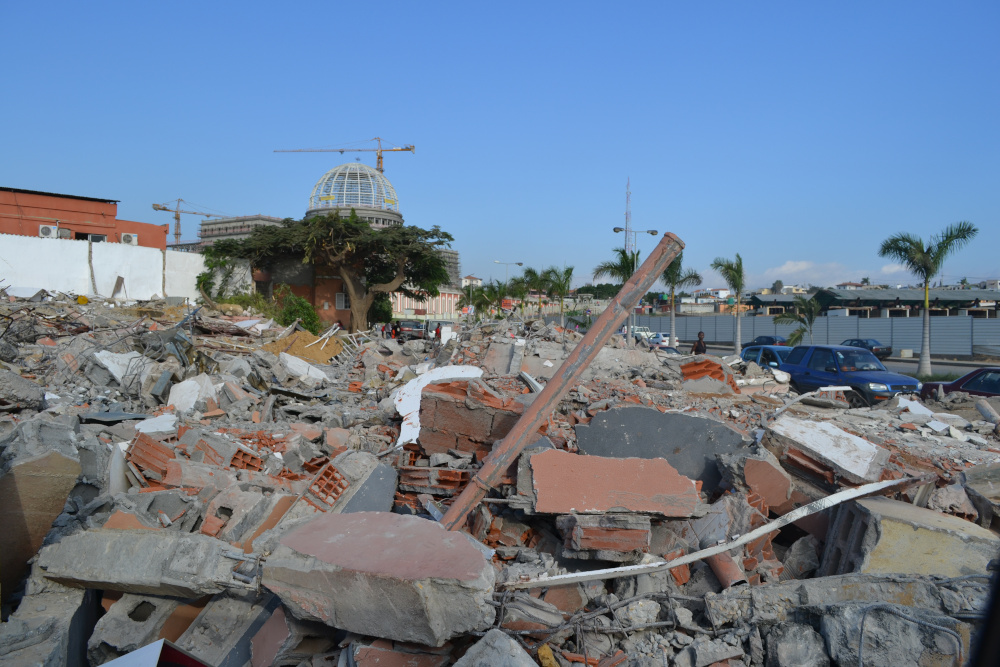
The aftermath of demolition. Luanda, 2012. Photo: Claudia Gastrow.
Democratic aesthetics
Aesthetic considerations not only determine who and what we are able to recognize as legitimate constituents of the urban, but as Gordon (2019) suggests, how we value and recognize the lives of those who produce and express themselves through those aesthetics. The focus on the aesthetic possibilities of musseques and other areas like them is not done with the intention of romanticizing the poor material conditions of many informal settlements or the results of state neglect. What shifting the boundaries of aesthetic recognition allows is an understanding of musseques as complex spaces. It recognizes them as locations from which indigenous formations and understandings of the urban are emerging. Luanda has undergone dramatic changes over the last two decades, and while there have been significant discussions about the need to transform musseques, there has been little discussion about how musseques might contribute to reconfiguring imaginations of cidade. Musseques are not just spaces of abandonment, they are spaces with professional house builders, where architectural and design considerations take place, and where conversations occur everyday about the size, style, and finishings of homes and yards. They generate aesthetic orientations that imagine an urban built world beyond stereotypes of poverty and neglect. Taking seriously the aesthetic worlds of musseque life does not simply mean incorporating musseques into existing understandings of desirable urbanism, but rather, shifting the boundaries and meanings of those understandings. This would entail recognizing the worth of the everyday aesthetic productions of hundreds of thousands of people whose homes and neighborhoods are generally currently glossed as unsightly and in need of intervention.
Aesthetics are central to contemporary African urbanism. This is not simply because aesthetic judgements are a means for states and developers to discipline urban populations, but because struggles over aesthetic recognition contain critical democratic potentials. Tracking emergent aesthetic orientations in African cities’ informal areas can help to imagine urban possibilities beyond the new city developments springing up across the continent. Taking seriously the aesthetic contributions of Luanda’s bairros would force a deeper discussion of what kinds of architectures and urban designs residents desire and value, a discussion which is, at heart, always a conversation about what kinds of residents cities should accommodate. Elite aesthetics presume elite residents. The recognition of the aesthetic demands of the majority entails the recognition of them as members of political and urban communities and with that the rethinking of the underlying logics determining city building. Aesthetic considerations position the city’s built environment as a site for democratic action as they become a means of questioning planning and design decisions presented as necessary by capital and elites. Being forced to explain why people cannot have larger rooms, the yards they would like, and higher ceilings, seemingly mundane concerns, can become a means for forcing a larger discussion about who shapes cities and who cities are for. As such, allowing urban aesthetics to be led by the majority holds the potential for fostering critical democratic practices rooted in the everyday bricks and mortar of Africa’s growing cities.
Claudia Gastrow (Twitter) is a senior lecturer in Anthropology at the University of Johannesburg. Her work broadly focuses on how the built environment mediates experiences and practices of political belonging. More recently she has begun researching histories of urban socialism in Angola as well as practices of financial enclaving in various cities across the African continent.
All essays on African Futures
Introduction: Africa’s Urban Futures
Claire Mercer
City of the Future: Lagos and the Afropolitan Imagineering Project of Owambe Urbanism
Grace Adeniyi-Ogunyankin
‘Colour Ni Green’: Ecological Futures in Nairobi Outlaw Style
Wangui Kimari
Aesthetics and the Making of Urban Futures in Luanda, Angola
Claudia Gastrow
Appropriating and Contesting Digital Infrastructural Futures in Urban Africa
Prince K Guma
Land Commodification and Tenure (In)Security: Spotlight on Peri-urban Accra, Ghana’
Divine Asafo
Centring the ‘Urban State’ in African Urban Governance Debates
Liza Rose Cirolia
Related IJURR articles on African Futures
A Shadowy ‘City of Light’: Private Urbanism, Large-Scale Land Acquisition and Dispossession in Ghana
Austin Dziwornu Ablo, & Bjørn Enge Bertelsen
Conceptualizing African Urban Peripheries
Paula Meth, Tom Goodfellow, Alison Todes & Sarah Charlton
Cities, Creativities and Urban Creative Economies: Re‐descriptions and Make+Shifts from Sub‐Saharan Africa
Jenny Mbaye & Andy C Pratt
Identity Building Through Mediation by African Tailors
Sofia Vilarinho & Henri Christiaans
Infrastructure Disruption in ‘Silicon Savannah’: Exploring the Idea of the Creative Class and their Relation to Quality of Place in Nairobi, Kenya
Lauren Rosenberg & Alan Brent
The Creative Night‐Time Leisure Economy of Informal Drinking Venues
Andrew Charman & Thiresh Govender
The Green Masterplan: Crisis, State Transition and Urban Transformation in Post‐Genocide Rwanda
Shakirah Esmail Hudani
The Real Estate Frontier
Tom Gillespie
Day Zero and The Infrastructures of Climate Change: Water Governance, Inequality, and Infrastructural Politics in Cape Town’s Water Crisis
Nate Millington and Suraya Scheba
Urban States: The Presidency and Planning in Luanda, Angola
Claudia Gastrow
Forefronts of the Sharing Economy: Uber in Cape Town
Andrea Pollio
‘The City of Our Dream’: Owambe Urbanism and Low‐income Women’s Resistance in Ibadan, Nigeria
Grace Adeniyi Ogunyankin
Boundary Work: Becoming Middle Class in Suburban Dar es Salaam
Claire Mercer
Silence and Voice in Nigeria’s Hybrid Urban Water Markets: Implications for Local Governance of Public Goods
Charisma Shonté Acey
Global Urban Policymaking in Africa: A View from Angola Through the Redevelopment of the Bay of Luanda
Sylvia Croese
Urban Fortunes and Skeleton Cityscapes: Real Estate and Late Urbanization in Kigali and Addis Ababa
Tom Goodfellow
Sisyphean Dilemmas of Development: Contrasting Urban Infrastructure and Fiscal Policy Trends in Maputo, Mozambique
Gabriella Y. Carolini
Idioms of Accumulation: Corporate Accumulation by Dispossession in Urban Zimbabwe
Beacon Mbiba
‘No Condition is Permanent’: Informal Transport Workers and Labour Precarity in Africa’s Largest City
Daniel E Agbiboa
Building God’s City: The Political Economy of Prayer Camps in Nigeria
Asonzeh Ukah
